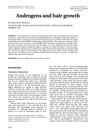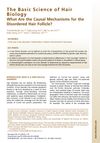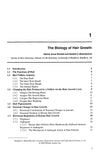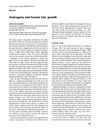TLDR Hair loss is caused by genetics, hormones, stress, and environment, and can be managed with good nutrition, stress control, and treatments.
Hair loss, or alopecia, is influenced by genetic, hormonal, immune, and environmental factors, with significant psychosocial impacts. Disruptions in the hair growth cycle, often due to hormonal changes and stress, are central to hair loss. Androgens, cortisol, and thyroid hormones are crucial, while immune responses and environmental factors also contribute. Preventive strategies include balanced nutrition, stress management, and topical treatments. Understanding these mechanisms aids in better diagnosis and personalized treatment plans for those affected by hair loss.
 209 citations
,
September 2008 in “Dermatologic Therapy”
209 citations
,
September 2008 in “Dermatologic Therapy” Androgens can both increase and decrease hair growth in different parts of the body.
102 citations
,
July 2020 in “International journal of molecular sciences” Hormones like testosterone and estrogen significantly affect hair growth and structure.
 29 citations
,
September 2012 in “Dermatologic Clinics”
29 citations
,
September 2012 in “Dermatologic Clinics” Hair disorders are caused by a complex mix of biology, genetics, hormones, and environmental factors, affecting hair growth and leading to conditions like alopecia.
 10 citations
,
January 2009 in “Elsevier eBooks”
10 citations
,
January 2009 in “Elsevier eBooks” Hair growth is influenced by hormones and goes through different phases; androgens can both promote and inhibit hair growth depending on the body area.
 8 citations
,
January 1996 in “Springer eBooks”
8 citations
,
January 1996 in “Springer eBooks” Male pattern baldness may be caused by factors like poor blood circulation, scalp tension, stress, and hormonal imbalances, but the exact causes are still unclear.
 157 citations
,
April 1994 in “Clinical endocrinology”
157 citations
,
April 1994 in “Clinical endocrinology” Androgens can cause hair growth in some areas and hair loss on the scalp.





